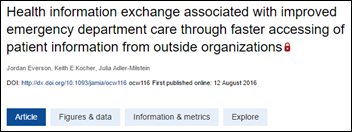typo, sorry. hundreds of billions.
News 8/17/16
Top News

Leidos closes its merger with Lockheed Martin’s Information Systems & Global Solutions business and adds several executives to its Board of Directors, including Gregory Dahlberg (Lockheed Martin), Surya Mohaptra (Quest Diagnostics), and Susan Stalnecker (DuPont). Originally announced in January, the merger will give Leidos an additional $5 billion in revenue thanks to legacy LM customers that include HHS, Homeland Security, and the Social Security Administration.
Webinars
August 24 (Wednesday) 1:00 ET. “Surviving the OCR Cybersecurity & Privacy Pre-Audit: Are You Truly Prepared?” Sponsored by HIStalk. Presenter: John Gomez, CEO, Sensato. Many healthcare organizations are not prepared for an OCR pre-audit of their privacy and security policies. This webinar will provide a roadmap, tools, and tactics that will help balance policies and budgets in adopting an OCR-friendly strategy that will allow passing with flying colors.
Contact Lorre for webinar services. Past webinars are on our HIStalk webinars YouTube channel.
Acquisitions, Funding, Business, and Stock

Citing an increasingly out-of-balance risk pool, Aetna CEO Mark Bertolini announces the company will reduce its public health insurance exchange coverage from 15 states to four next year. Humana and UnitedHealth have made similar announcements in the last several months.

Less than a week after announcing its $70 million Series E, Plymouth Meeting, PA-based Accolade announces plans to hire additional staff at its new office in Prague. It expanded to the Czech Republic last month, after opening a second office in Seattle in February.
People

Sensei promotes Ashley Reynolds to COO.

Verisk Health appoints Emad Rizk, MD (Accretive Health) CEO and board director.


I2I Population Health names Jennifer Windrow (ICA) SVP of client delivery, and Jennifer Calohan, RN (Patient Engagement Advisors) VP of client success.
Nick van Terheyden, MD (Dell Services)and Jessica Federer (Bayer) join the MedicAlert Foundation Board of Directors.
Announcements and Implementations

Providers in California, Minnesota, Texas, and Virginia go live on The Sequoia Project’s Carequality Interoperability Framework. Early adopters include customers of Athenahealth, EClinicalWorks, Epic, HIETexas, NextGen, and Surescripts.
Surescripts increases its year-over-year processing of secure health data transactions by 48 percent, facilitating 9.7 billion transactions in 2015. Last year also saw a 10-percent increase in the company’s digital prescription transactions – a figure no doubt aided by state-based e-prescribing mandates.
Shamrock Solutions develops a cloud-based, automated EOB reconciliation tool for enterprise content management systems from the likes of Lexmark and Hyland.
Get Real Health adds the MyDirectives health crisis care-planning tool to its InstaPHR.
Technology
Translational Software develops a FHIR-based pharmacogenomics API to help providers, labs, and vendors create apps that can improve prescription ordering workflows, alert prescribers to potential interactions and adverse drug events, and suggest different medications.

FormFast launches FormFast Capture, a paper-to-digital records conversion service that automatically archives forms within the EHR.
Champ Software adds Direct messaging capabilities from Secure Exchange Solutions to its Nightingale Notes EHR for community and public healthcare agencies, home health agencies, and schools of nursing.
Sales

University Health Care System (GA) integrates Right Patient’s photo biometric patient identification system with its Epic EHR.
The Bahamian Ministry of Health and the Public Hospitals Authority will install Allscripts Sunrise at its three hospitals and 100-plus clinics. The health system is embarking on a complete overhaul that includes upgrading existing facilities, building several new ones, and extending clinic hours.
University of Utah Health Care implements Imprivata’s PatientSecure identification technology in hopes of reducing duplicate medical records and improving patient safety at its hospitals and clinics.

Franciscan Alliance (IN) selects unified provider management services from Phynd Technologies.

University Health Shreveport/Louisiana State University Health implement TelePreop’s telemedicine software to better coordinate pre- and post-operative care.
Research and Innovation

A JAMIA study finds that patient data obtained from an HIE is available faster and is more frequently reviewed by clinicians than data obtained via fax or telephone. The study also suggests that access to HIE data reduced ER visit length by one hour, reduced the likelihood of admission by 2.4 percent, and reduced the average cost of care for the visit by $1200.
A Xerox survey of 761 insured consumers reveals that providers and payers don’t seem to give them enough credit when it comes to managing their own care. Fifty percent of those surveyed believe they take complete responsibility for their health, but only 6 percent of providers and payers agree. Adding insult to injury, 90 percent of healthcare professionals take a rather paternalistic attitude in their belief that consumers need their help and encouragement to prioritize healthy living, while only 55 percent of consumers concur. A similar disconnect was seen between consumer and provider/payer sentiment around comparison shopping for healthcare
Sponsor Updates

- The CoverMyMeds team contributed more than 45 new automated toys and modified 30 of those so that they can be used by kids with disabilities as part of a Replay for Kids workshop.
- AdvancedMD will host its annual user’s conference October 11-13 in Salt Lake City.
- Attendees share why they love AirWatch’s Connect Atlanta conference.
- Besler Consulting and HCS will exhibit at the HFMA Region 3 Inaugural Summit August 21-23 in Wilkes-Barre, PA.
- Meditech publishes a new case study, “Avera Health Reduces Sepsis Mortality with Help from Meditech’s EHR.”
- FormFast offers the “Top 4 Reasons to Modernize Your Patient Access Department.”
- Aprima showcases MACRA/MIPS readiness at its 2016 user conference.
Blog Posts
- MIPS Scoring & Your Practice: What You Should Know (AdvancedMD)
- Risk Algorithms: The Keystone of Value-Based Contracting (Arcadia Healthcare Solutions)
- Is Leakage a Dirty Word? (Evariant)
- CMS Puts the Gas on Mandatory Bundles (HealthLoop)
- Spotlight on the Data Analyst Role in Healthcare (Evariant)
- Major takeaways of CMS Transmittal 1681 (Besler Consulting)
- What are Bundled Payments Really About? (Caradigm)
- Chronic Care Management Done Right (CareSync)
- Transforming Access Through Scheduling Redesign (Culbert Healthcare Solutions)
- Performance at the Highest Level (Spok)
- Collaboration is Critical in Care Model Transformation (ECG Management Consultants)
- Top 5 Hospital Application Portfolio Complexity Drivers (Galen Healthcare Solutions)
- The Two Sides of MACRA: Examining the Pros and Cons (Hayes Management Consulting)
- Working from Home – Do You Have What it takes? (HCTec)
- Epic Credentialed Trainers: Before, During & Post Go-Live (The HCI Group)
- Shared Decision Making “Topped Out?” Think Again (Healthwise)
Contacts
Mr. H, Lorre, Jennifer, Dr. Jayne, Lt. Dan.
More news: HIStalk Practice, HIStalk Connect.
Get HIStalk updates. Send news or rumors.
Contact us.







Aetna’s pull out of ARA was completely predictable, particularly when the feds /congress refused to cover the losses they originally promised. Those promises were what convinced the big insurers to sign on to Obamacare seven years ago. You would think the smart guys in the room at Aetna would have figured out back then that it was all empty ‘political’ promises, but guess they got hypnotized by the dream of really big bucks.
Since the gvt can force employers make all kinds of coverage available, make states include Cadillac coverage, make religious groups cover services outside their theology, then why doesn’t the gvt just mandate that all insurance companies must cover any an all individual or group applicants. Come to think of it, they are on their way there with the requirement insurers not deny based on pre-existing conditions.
Sim
There’s another side to the Aetna story. They were depending on their merger with Humana to support the costs of being on the exchanges. With the DOJ blocking that merger, the numbers weren’t there. Some are saying it’s a retaliation against the DOJ, but it seems more financial. More details here: http://www.businessinsider.com/aetna-humana-merger-reason-for-leaving-obamacare-2016-8
The Feds can’t have it both ways — i.e., promoting “competition” and creating a regulatory environment that encourages consolidation.